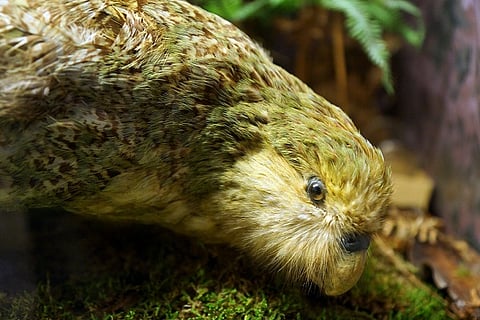
- News Updates
- PSU Watch
- Defence News
- Policy Watch
- हिन्दी न्यूज़
- Jobs Watch
- States News
- Event News

New Delhi: For New Zealand, the wait has been long but every bit worth it. After the last breeding season in 2016, the country's critically endangered flightless, nocturnal parrots, called Kakapos, have had a record-breaking breeding season this year which can turn the tide for these birds. Forty-nine out of 50 breeding females laid eggs this year. The last record-breaking breeding season was in 2016, when 37 chicks fledged, according to a report by The Guardian.
This is momentous not just because New Zealand has gone to great lengths to ensure that the bird does not go extinct, but also because these parrots mate every two to four years, when their favourite fruit grows in Rimu trees — a time of the year known as "mast year" — making it even more difficult to spur the population growth.
As of today, the total population of Kakapos, which used to be one of New Zealand's most common birds and are the world's fattest parrots, stands at 147 only. They reached the brink of extinction over time as they were hunted, killed by introduced pests, and lost their forest homes to farming. The population became so small that every Kakapo had a name: Ruth, Hoki, Suzanne and Zephyr, etc.
And therefore, New Zealand started one of the world's most intensive management programmes that any species of the world has been subjected to.
Under this programme, a smart transmitter was attached to every Kakapo's body and remote monitoring systems were embedded in their nests. Till today, Kakapo chicks are checked on every night by rangers as they grow and are hand-reared by the Department of Conservation (DoC) staff. Currently, the rangers are keeping a watch on seven chicks as they grow.
"When you've only got a population of 147 anything could wipe them out and they could become extinct quite quickly," said Dr Andrew Digby, a science advisor to the DoC's kākāpō recovery programme.
Therefore, chicks are being raised on two predator-free islands off the coast of New Zealand on protected sanctuaries that are pest-free. Eventually, when the population grows, the Kakapos will be rehabilitated in mainland New Zealand's bush, cities and towns. However, there's time for that. "We want to get 150 breeding females, and ideally some unmanaged populations before we can start to relax a little bit," said Dr Digby. He added that the population will have to get up to 500 at least for them to consider reintroducing Kakapos to the mainland.
In order to make sure that their efforts were leading to results, Digby said that his team gave "no privacy" to the bird species even during the critical breeding season. "I can be anywhere in the world and log in and find out which kākāpo mated last night, who they mated with, how long they mated for, the quality of the mating – its real big brother stuff," he said.
